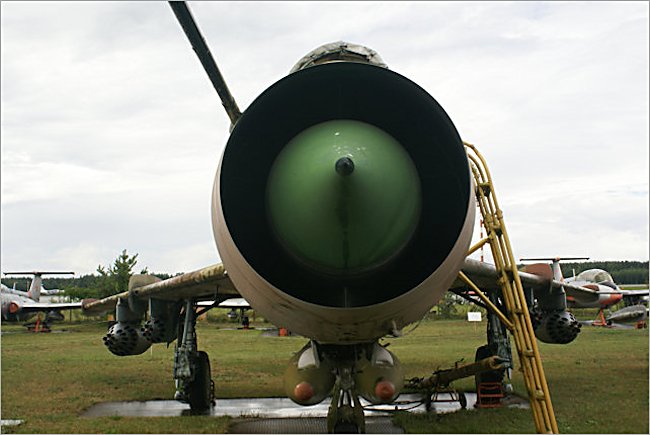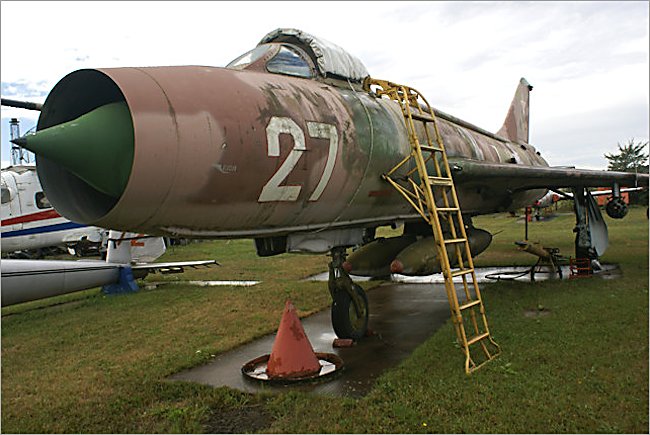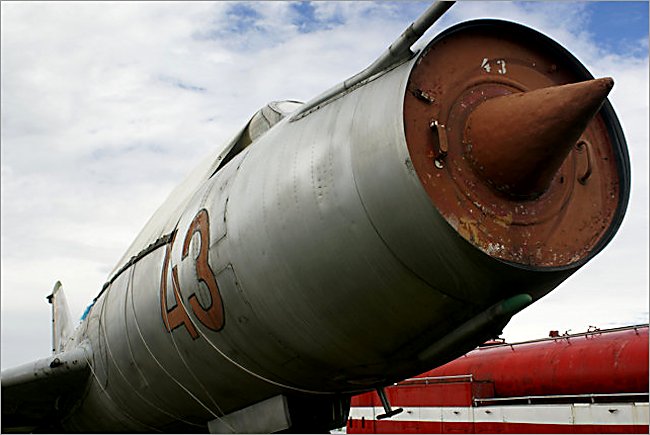SU-7BKL Ground Attack Jet
The Sukhoi SU-7BKL Fitter Soviet Ground Attack Jet Fighter only had a crew of one. Its armament options on six hard points were 2 x NR-30 cannons (30 rounds each) 4 x unguided rockets S-24 (240 mm caliber) or 6x unguided rocket pods (up to 192 rockets) or various bombs (or napalm pods) with total 3000 kg weight. A 8U69 5-kiloton nuclear bomb could be carried on the left fuselage hardpoint. Various additional under wing fuel tank options were available.
It was introduced in 1959 and retired from Soviet service in 1986. It was produced between 1957 to 1972 and 1,847 were built. It was powered by a single Lyulka AL-7F-1 afterburning turbojet engine. Its maximum speed was 1,150 km/h (715 mph, Mach 0.94) at sea level; 2,150 km/h (1,335 mph) at high altitude. It had a service ceiling of 17,600 m (57,740 ft). Comparable NATO aircraft were the RAF Hawker Hunter and USAF F-105 Thunderchief.

Photograph taken at the Russian Aircraft Museum next to Riga International Airport Latvia
When the Sukhoi OKB was re-established in 1953, their first task was to develop a fighter that was based upon the American F-86 Sabre. They designed the Su-7 Cold war Fighter with a highly swept wing and supersonic performance that was better than the new F-100 Super Sabre. Despite its high speed performance, the aircraft was not widely used. Like many fighters that were out classed by a rival design, the Su-7 found new life as a fighter-bomber. The Sukhoi OKB made a number of refinements for low-altitude operations and the Su-7B was born. It was noted for its ability to withstand large amounts of combat damage and still fly.
In 1960's there was wide spread opinion among military specialists that military jets have to be able to fly on soft-surface runways during war conflicts. Because main concrete runways could be easily put out of operation by the enemy strikes. This idea influenced the design of the Sukhoi Su-7B fighter-bomber (NATO-code Fitter). NATO maintained its habit of assigning Soviet fighters with F based names and bombers with B names like bear or backfire. The Sukhoi Su-7BKL design had a new wheels-and-ski landing gear, gunpowder accelerators, two-canopy breaking parachute, increased amount (six) of weapons pylons, upgraded bombsight.

Photograph taken at the Russian Aircraft Museum next to Riga International Airport Latvia
New gears were adopted for taxiing, take-off and landing on soft-surface aerodromes. Front gear received tyre with increased diameter and on main landing gear were installed small steel skis, together with wheels. During take-off or landing on hard surface were not working due to their suspension, not allowing to touch the runway. But they started to work when wheel became to deepen into soft soil. Skis helped to distribute pressure and not allowed wheels to get deeper and to brake aircraft movement.
Komsomolsk-na-Amure Aviation Factory started to produce new upgraded variant in 1965 and finished in 1972. At the same time another Su-7B variants were produced; Su7BM/BMK/UM and UMK. Su-7BKL's were used by Soviet, Polish and Afghanistan Air Forces. Afghanistan widely used another variant, Su-7BMK, but due to high combat losses and lack of spare parts, small amount of BKL's were exported to there in 1980's.

Photograph taken at the Russian Aircraft Museum next to Riga International Airport Latvia
At the end of 1960's Su-7B and its variants were upgraded with electronic countermeasures pods to confuse planned rival's air defence. On the right underwing pylon was attached SPS-141 (142, 143) system pod. This ECM system provided less probability the aircraft to be shot down. On the opposite side usually was attached UB-16-57 pod with unguided rockets.
The Su-7 saw combat with Egypt in the 1967 Six Day War, the subsequent War of Attrition, and saw use in the Yom Kippur War by the Egyptians to attack Israeli ground forces. The Indian Air Force used the Su-7 extensively in the 1971 war with Pakistan. The six Indian Su-7 squadrons flew almost 1,500 offensive sorties during the war, and undertook the bulk of the daytime attack efforts. The IAF managed to retain a very high operational tempo with its Su-7s, managing a sortie rate of six per pilot per day. Fourteen Sukhois were lost during the war, mostly due to AA-fire as IAF pilots conducted multiple passes over targets with insufficient fuel, but the type had acquitted itself well. After the war was over, it was found that the aircraft had received heavy AA fire in service , but still managed to fly home safely.
Unconfirmed report mentions, one pilot RG Kadam of TACDE had shot down an F-86 Sabre flown by FL AJ Siddiqu, but was shot down by WC Hashmi, before he could make it back to base. However the kill was not mentioned by the Indian air force because it was not reported by the pilot. Similarly Wing Commander HS Mangat's Su-7 was badly damaged by a Sidewinder missile fired from an enemy MIG-19, the impact was so severe that half the rudder was missing, the elevators, ailerons and flaps were severely damaged, & half the missile was stuck in the chute pipe. The pilot made it back to his base, while Pakistan air force reported this incident as a kill